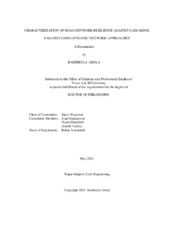| dc.description.abstract | Transportation infrastructure is subject to many disruptive events, and the economic, social, or environmental consequences of these disruptions on these systems are becoming increasingly dire. Due to the recent changes in both internal and external factors in transportation systems, both the consequence and frequency of disruptive events have been growing in recent decades. While actual disruptions and disasters in transportation network breakdown can provide important learning opportunities, these lessons are prohibitively expensive in economic, social, and environmental terms. Re-creating these disruptions in laboratory settings is impossible, and real-world data on the performance profile of the critical infrastructure systems during disruptions are extremely challenging to get. Therefore, using simulation-based approaches for (1) studying the transportation systems' disaster response; (2) examining its performance profile during a wide-spectrum of disruptions; (3) identifying factors contributing to the transportation systems' resilience are becoming increasingly imminent. This study aims to make transportation systems, more specifically, road networks, more resilient to disruptions. To that end, this research has four interwoven objectives.
First, this research examined the validity and relevance of robustness metrics proposed in the literature in the context of road networks and characterize the road network robustness under many disruptive events. It has been found that the performance profiles of the road networks under different disruptions scenarios are significantly different. This study also proposed a new measure, called expected robustness, to assess road networks' connectivity considering disruptions' uncertain nature.
Second, this study modeled the cascading failures in the road network using dynamic network approaches and characterize the road network's performance profile under the different types of cascading failures. The study under this objective concluded that the variance in the road network's performance profiles under cascading failures depends both on the magnitude and locations of disruptions.
Third, this study proposed a way to quantify the interdependence among critical sectors and characterize the building blocks' sensitivity of accessibility on the other features of the interdependent critical infrastructure systems. Findings from this objective include (1) locations of the fire stations that are critical for accessibility of households; (2) the extent of colocation interdependency between flood control and transportation network plays an important role in ensuring the accessibility.
Fourth, this study proposed a framework that could be used to measure the holistic impact of a certain type of change on the transportation infrastructure. This research has concluded that a transition matrix-based approach could be used to measure the overall implications of changes or shifts in the configuration of the system operations.
Contributions of this study could be summarized from theoretical, methodological, and practical perspectives. On the theoretical side, this study examined the performance profile of the road network using graph-theory-based approaches. It reduced the gap between findings between theoretical graphs and real-world networks by characterizing the vulnerability of the road networks to various disruptions types and magnitudes. This study proposed ways to model and measure cascading failures in the road network on the methodological aspect. On the practical side, this study demonstrated the applicability of the proposed method in actual settings by case studies that include Houston emergency service network, flood control network, and the Texas freight network, the importance of inter-sector collaborations and more active type of management of critical infrastructure systems has been demonstrated. These results, insights, and findings could have important policy implications for reducing transportation networks' vulnerability. | en |


